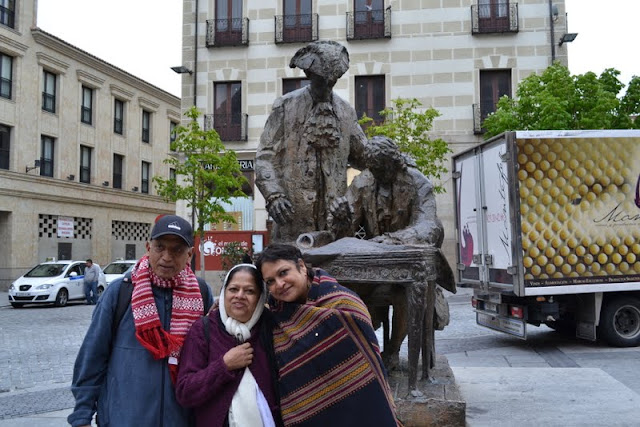We bid good bye to Portugal and Lisbon and headed
towards Salamanca. The city lies about 220 KM Northwest of Madrid on the river
Tormes. It is small town and is the most important University City in
Spain. The university was founded in 1218 and is the oldest university in
Spain. The weather was extremely cold and we were under dressed.The city is full of life with many youngsters making it their home for studies.
We were kept
occupied with a short documentary on ‘History of Cork’ and ‘Olive Oil’. The
film showed us how the oil is made from the very beginning – a very interesting
and educative film. Plucking the olives to processing is done in 24 hrs. Extra
virgin oil is untouched; the acid content is low and hence good for cooking. More
the acid, lower the quality. The oil is stored either in a colored glass bottle
or in a tin container to keep the sunlight away. Good olive oil when rubbed in
your hand emanates an earthy smell of the country. Grading the oil is through a
series of sipping, tasting and rolling on the tongue – probably like wine and
tea.
We later on stopped in a village by the name of ‘Avilla’ city of 'Stones and Saints' where
we were treated to ‘Churros’ (Spanish doughnut)
a traditional Spanish Dessert developed centuries ago by shepherds. Up
high in the mountains, fresh baked goods were impossible to come by, so the
ingenious, nomadic folk of the hills came up with a delicious cake-like,
cylindrical, daily staple which they could easily cook in a pan over an open
fire. This was the birth of Churros. They are normally eaten for breakfast
dipped in hot chocolate. The weather was perfect for Churros and everyone
thoroughly enjoyed the Spanish delicacy.
Figure 1 - A very interesting statuette on the way to the
restaurant
Figure 2 - Taberna for Churros
Figure 3 - Death by Churros served with hot chocolate
sauce
Figure 4 - After Churros
A lady from our group fell down on the road while getting
down from the bus. Ms Collen had to be hospitalized for emergency care in a
nearby hospital. She joined us a day later and out of danger.
We then visited Fatima. It is said that, Six times, from the
May 13 to Oct 13, 1917, the Virgin Mary appeared to three shepherd children in
the diocese of Leiria. A new church is under construction, however just as
beautiful, an older church was constructed here in 1928, and millions of
pilgrims visit each year. Fatima is one of the most visited holy places for
Catholics from around the world.
Figure 5 – A superb piece of architecture at Fatima
Figure 6 – A staunch devotee walking on her knees in
prayer - Fatima
Figure 7 – View of the church
Figure 8 – Photo op
Figure 9 – Kats posing as the savior
Figure 10 – During the technical halt –
a very satisfied couple
Figure 11 – The group
Figure 12 – Jai and Self
Figure 13 - Roman Bridge of Salamanca.
Of its arches,
fifteen are Roman of the 1st century BC. It stands on 26 semicircular arches and robust pillars. It forms
part of the 'Plata' Roman road that
linked Merida with Astorga.
Figure 14 – Architecture in the city - The statue is of a famous novel written about the adventures of a boy in
Salamanca named Lazarus, who has the job of guiding a blind man.
Figure 15 - Statue nr La Clerecía - With Dore, Lalitamma and Jai -
Figure 16 - Plaza Mayor
Figure 17 – A view of the cathedral
Figure 18 – A road from the Roman times
Figure 19 – Fascinating landscape
outside of Salamanca
Figure 20 – Walls of Avilla - With Bob who celebrated his
52nd wedding anniversary in Salamanca.
Figure 21 Walls of Avilla - Jai absorbing the nature
Figure 22 – Avilla from a hill top
Figure 23 – Rare photo op
























No comments:
Post a Comment